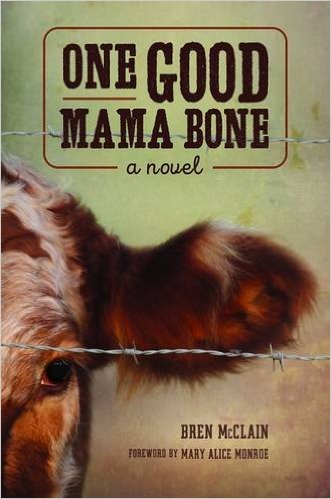One Good Mama Bone: A Novel
- By Bren McClain
- University of South Carolina Press
- 280 pp.
- Reviewed by Alice Stephens
- March 3, 2017
The 1950s Deep South comes alive in this folkloric tale of love, sacrifice, and redemption.

For those of us who choose to be carnivores, it is easy to ignore what happens before we purchase neat cuts of meat hygienically wrapped in foam and plastic. We do not think of the being who died for our dinner, or the life of that being, or the death of that being. When we see a photo of a pretty cow peacefully munching grass in a green pasture, we do not think, as one of the characters in Bren McClain’s debut novel, One Good Mama Bone, does, that the cow has “a bright future in somebody’s deep freeze.”
Rule number one for anyone raising animals for slaughter: Never give the animal a name.
And that is the first mistake that young Emerson Bridge Creamer makes when his mama, despite being destitute and under a mountain of debt, buys a newborn steer so that her son can enter him in the annual Fat Cattle Show. The boy immediately develops a strong bond with the animal, naming him Lucky.
Being simple folk with a limited grasp of the world around them, Emerson Bridge and his mama, Sarah, do not understand that at the end of the competition, the steers are destined for the butcher’s counter. Sarah does know the winner receives a lot of money, and she sees the steer as a way to get them out of poverty while helping Emerson Bridge recover from the recent death of his father.
But Lucky has been taken away from his mother before he was weaned, and she is one determined cow. And that’s when the book starts to stray from a traditional novel to something more mythical. Even biblical. For the 16-year-old mother cow, the equivalent of the biblical Sarah’s age when she gave birth to Isaac, breaks through a barbed-wire fence and somehow finds her way to her distant calf.
And so, just as Emerson Bridge finds a buddy in Lucky, Sarah gains a soulmate and mentor in Mama Red, as she calls the mother cow. Telling Mama Red all the things she could not tell a human, Sarah confesses, “I don’t know how to be a mama.” That is because her own mother was of the wicked-stepmother mold: selfish, cruel, and prone to hitting Sarah with a flyswatter while snarling, “You-ain’t-got-you-one-good-mama-bone-in-you.”
Sarah also reveals to Mama Red, “See, my boy don’t look like me. That’s because he’s not my flesh and blood.” Unbeknownst to everyone, including Emerson Bridge, his real mother is Sarah’s best friend, who killed herself right after giving birth to her illegitimate son, fathered by Sarah’s husband while her own husband was at war, killing “slant eyes.”
One Good Mama Bone is a true American story because it is a hybrid of genres: The plot is Southern Gothic, the twists and turns are fairytale, the prose and characters are folkloric.
These people are simple. Their needs are elemental: love, respect, approbation. These universal needs underpin the actions of most literary characters, but generally those actions are explained by a close examination of the inner workings of a character’s mind, which helps to render her flesh and bone rather than a flat caricature.
Emerson Bridge, his mama, and the rest of the characters are more Hansel, Gretel, and the witch than Quentin, Caddy, and Benjy Compson. They are prototypes that stand in for all humanity, not deep psychological portraits of complicated individuals.
The homely, comfortable stitching of the prose evokes rural, hardscrabble lives, shot through with lovely flourishes of clean-lined poetry, as when Emerson Bridge runs out of the house angry, “the screened porch door slapping big, then little, then nothing.”
Sometimes that poeticism bruises a little purple, as when Mama Red is getting ready to give birth to Lucky: “She would know, and it would come from a place deep inside where maternal love lives and maternal love grows, a place that is regardless there, never wavering there, nonnegotiably there.”
As with all folktales, this one is heavily shadowed by dark moments, including the cruel deaths of many of the principal characters. And as with all fairytales, we eventually get to a happy and hopeful ending. But the author does not leave us to dream of happily ever after. She makes clear that such an ending requires the sacrifice of tender, gentle creatures.
Alice Stephens’ column, Alice in Wordland, appears monthly in the Washington Independent Review of Books. She will appear on the "Across the Cultural Divide" panel at this year's Washington Writers Conference on Sat., Apr. 29th, in College Park, MD.
_80_122.png)
